Important tool aids production and health management
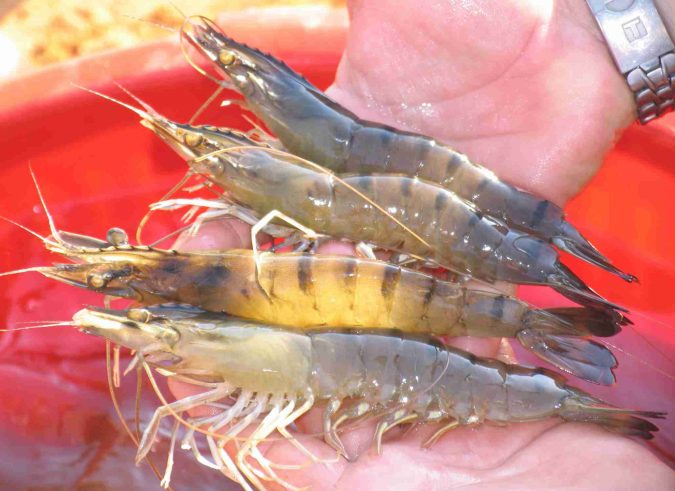
Periodic sampling of shrimp populations is an important management tool during the production cycle. In aquaculture, the process of sampling has the objective of generating information about a large group of animals – such as a shrimp population in a pond – by looking at a small number of individuals. Routine sampling is common in most farms to monitor shrimp populations, to determine individual and average size and weight of animals, to assess their physical condition, appearance and product quality, to evaluate their overall health, and to test the population for the possible presence of known pathogens or disease.
Sampling is generally carried out by collecting samples using cast nets thrown from boats or pond levees, although with their increasing use, properly managed feed trays (using daily feed consumption combined with percent body weight curves) can provide adequate population estimates.
In areas subject to wide variations in tidal magnitude due to lunar/tidal cycles, shrimp commonly behave differently during spring and neap tides. Typically, shrimp population sampling is done every one or two weeks. Resulting estimates of population size and survival rates can be remarkably accurate if properly carried out, or very inaccurate for several reasons, including shrimp activity (molting, lunar/tidal cycle), and human error and/or negligence. In general, to improve the validity of a shrimp population sampling program, sample collection should be carried out after lowering the pond water level, by experienced personnel using a large and heavy cast net, and the number of sampling stations and frequency of sampling should be increased as much as possible. It is important for a farm to establish adequate in-house sampling methods that adequately reflect its needs and capabilities.
By considering and eliminating, or at least stabilizing the most important biases in your technique, you can produce consistency in resulting data. In general, the biases are relatively consistent and with experience you can develop “fudge” or “correction” factors to compensate for the biases and produce good workable approximations of shrimp size and populations for your specific site and biases. Cast net samples are biased by several factors, which should be recognized and acted on as much as possible.
Shrimp species can affect sampling
Shrimp distribution and behavior varies significantly by species. A good example of species-specific behavior that affects sampling, and pertinent recommendations were provided by Clifford (1998), in his review of Pacific blue shrimp (L. stylirostris) pond culture. In describing the distribution patterns of this species in ponds, he reported that blue shrimp have a tendency to distribute themselves in non-homogeneous patterns in the ponds, and will frequently congregate in clusters, especially in shallow ponds. He stated, “The non-uniform distribution of the shrimp produces large variations in shrimp capture during population sampling, which complicates accurate estimates of survival.”
In order to reduce the variations in shrimp capture during population sampling, the following measures are recommended: 1) All ponds > 30 days in age should be sampled weekly, at 3-4 fixed sampling stations per hectare (ha); 2) Use nylon cast nets with a minimum of 3 kg of lead weights, and up to 4-6 kg of lead if sampled ponds are transparent or shallow; 3) Sample during the early hours of dawn, or if necessary, at night, 4) When using a boat and motor, shut off the motor as the sampling station is approached; 5) Do not feed or exchange water immediately before or during the population sampling event; 6) Avoid altering the sampling crew, equipment and routine. By sampling weekly you will generate a moving average of the last three or four weekly samples, and this reduces the variability between samples, and leads to a more accurate estimate of survival. A four-week moving average also will include all lunar phases in the sampling period.
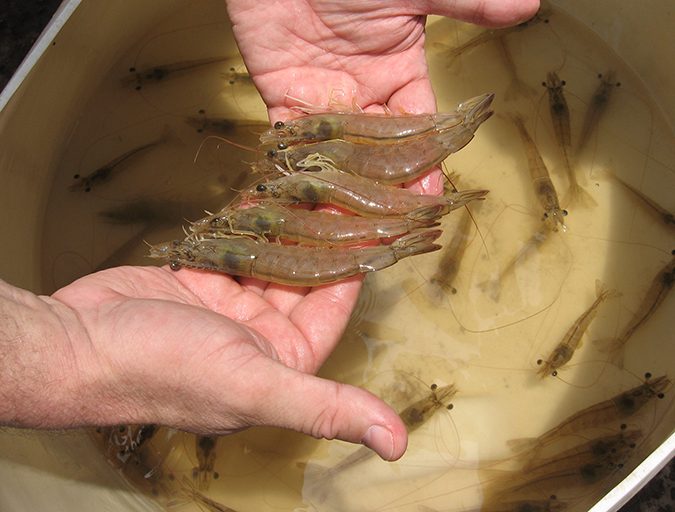
Shrimp density and size
Significant size variation/distribution in a shrimp population can affect sampling results. Smaller shrimp generally tend to stay in the shallow areas of ponds, so it is important to sample evenly the pond area as much as it is practical. Also, larger shrimp are faster – and more easily escape the settling net – than small shrimp and there is a consistent bias toward catching more animals of the smaller sizes. Accuracy of sampling will increase with increasing animal density as you would expect.
Pond bottoms
The pond bottom texture and contours must be smooth. Ponds that don’t have smooth bottoms are not good candidates for cast netting. The nets simply will not contain the shrimp when they settle if they are not sealing well to the bottom. Ponds with lots of mangrove roots and other debris tend to keep cast nets that are thrown into them. Ponds with sandy soils allow more animals to burrow and evade/escape the net, and will require a higher correction factor when sampled.
Pond water
Pond water characteristics vary with season and time in the diel cycle, and also due to various phenomena such as El Niño, monsoons, etc. Water quality variations in a pond will produce biases in cast net sampling. Ponds should be sampled when they have been static for several hours. Water flow (as during water exchanges) tends to unevenly distribute shrimp, which normally congregate near inflows.
Sometimes daytime sampling seems to work better, apparently because the shrimp are less active and are more evenly distributed than during the evening. Cast netting in daylight tends to make sample techniques more viewable by supervisors, and therefore more uniform and “supervisable.” Early morning and low bottom levels of dissolved oxygen (DO) can also cause the shrimp to be unevenly distributed as they seek higher DO at the surface and in the pond side shallows. Cool pond water tends to make for slower shrimp and may push populations upwards compared to those taken at optimum water temperatures.
Water depth affects the time the cast net takes to reach the pond bottom, so the longer the cast net takes to sink the more shrimp are able to evade/escape the net. Sampling at night or at dawn might be better under some conditions, like in ponds with high transparency. No water exchange or feeding should be done immediately prior to sampling, because these will after the normal distribution of shrimp in ponds.
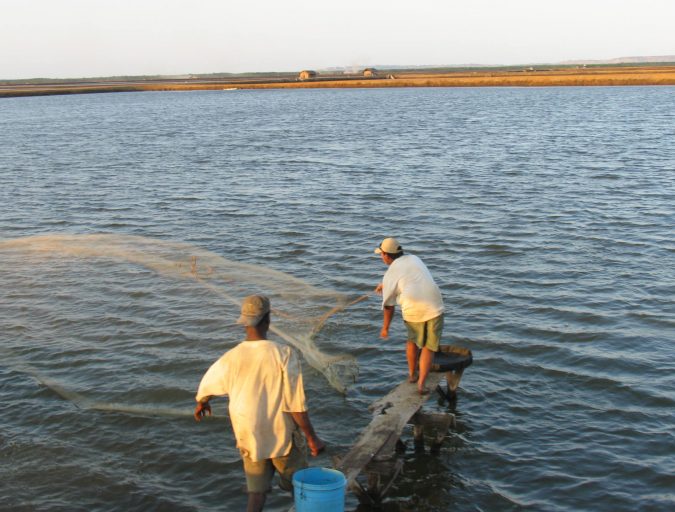
Cast nets used to collect shrimp sample
If results are to be comparable, the cast nets used must be consistent from pond to pond and crop to crop over time. Besides various sizes, there are at least two types of cast nets – one has static drawstrings that only partially purse the net and the other has drawstrings passing through the center of the cast net to purse the net as it is pulled in. If possible, use the latter type because it closes the net completely.
A mesh size must be used that retains representatives of the smallest shrimp size class present. In general, you should use the largest and heaviest cast net that the sampling personnel are comfortable with, having a 1/4- to 1/8-inch mesh aperture for sampling small juveniles, and 3/8-inch mesh to sample larger animals. Be aware that when the mesh size changes, so do the dynamics of its settling rate and resulting shrimp catching potential, so you may or may not want to change mesh sizes during the growout.
The cast net diameter must be the same to be able to compare results between ponds and crops. The diameter also becomes more difficult to cast in a circular shape as it gets larger, and as its weight/area increases it becomes more work for the thrower and his consistency will likely suffer if there is a lot of casting to be done. Try to determine the effective area of each net by having the people involved in sampling cast a few times into a clear pond with 50 to 100 cm of water, and measuring and averaging the actual area of coverage of the net. This also allows for the calculation of correction factors for different size nets, based on the discrepancy between estimated population and real population after harvest. These correction factors are developed at each farm through experience and observation, and can become quite accurate after enough data are available, although they usually require continuous fine tuning.
The cast net netting material is an important performance factor. Mono-filament netting sinks faster than woven twine when compared to the same mesh size, diameter and weight nets. Each has different rates of drag resistance to settling. Settling rate is also controlled by the number of lead weights used on the net, so if there are multiple nets they must be identical. Again, it is being consistent that make any biases manageable.
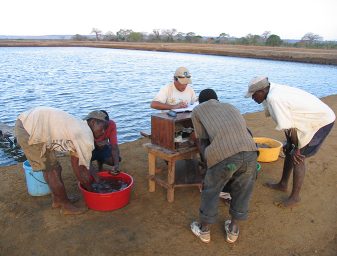
Sampling stations
Fixed sampling stations should be setup and used that are marked with wooden stakes, buoys or other markers. Most of the sampling stations should be established in areas outside of the pond’s internal drainage canals. Two to five stations per ha is an adequate number, depending on resources and needs. In general, increasing the number of stations should reduce sampling errors.
Personnel
The same people throwing the cast nets should be used in sampling. The variation that exists in the way people throw a cast net is surprising. Some throwers just can not get the net to expand into a complete circular shape, and end up throwing kidney (or other figures) shaped casts. Use two people for cast netting and you may get two very different results for the same pond. Also, there should be a pre-determined maximum number of throws per day for every person, because regardless of skill, arms get tired and this will affect the sampling. Personnel new to the sampling procedure must be closely supervised initially, as they will tend to bring back the largest animals instead of collecting sample animals at random.
Authors
-

Durwood M. Dugger
President
BioCepts International, Inc.
Vero Beach, FL USA
www.biocepts.com[109,111,99,46,115,116,112,101,99,111,105,98,64,114,101,103,103,117,100,100]
-

Darryl E. Jory, Ph.D.
Editor Emeritus
Global Aquaculture Alliance
Portsmouth, NH, USA[103,114,111,46,101,99,110,97,105,108,108,97,97,103,64,121,114,111,106,46,108,121,114,114,97,100]
Tagged With
Related Posts
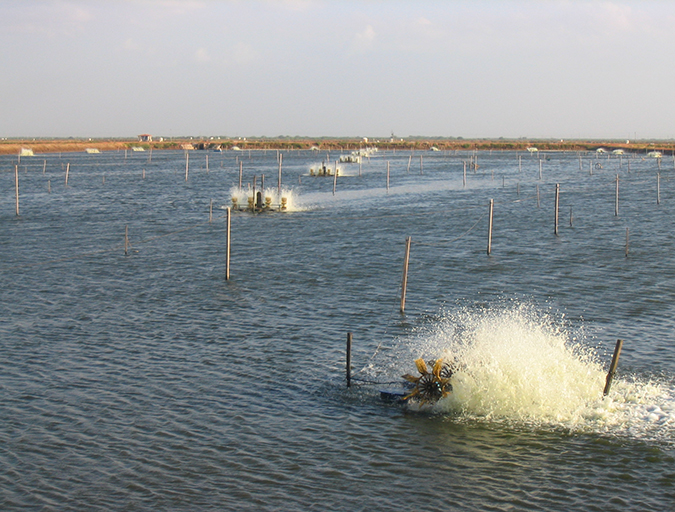
Health & Welfare
Proper water circulation in aquaculture ponds critical
Promoting water circulation during the day time is an effective strategy to enrich pond water with oxygen produced by photosynthesis, and can significantly reduce the costs of night time supplemental aeration.
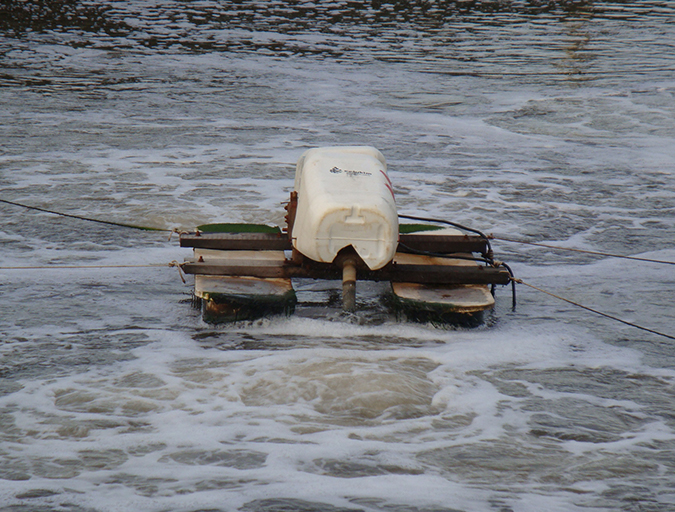
Health & Welfare
Proper water circulation in aquaculture ponds, Part 2
Promoting water circulation during the day time is an effective strategy to enrich pond water with oxygen produced by photosynthesis, and can significantly reduce the costs of night time supplemental aeration. Many types of effective, commercial water circulators are available.
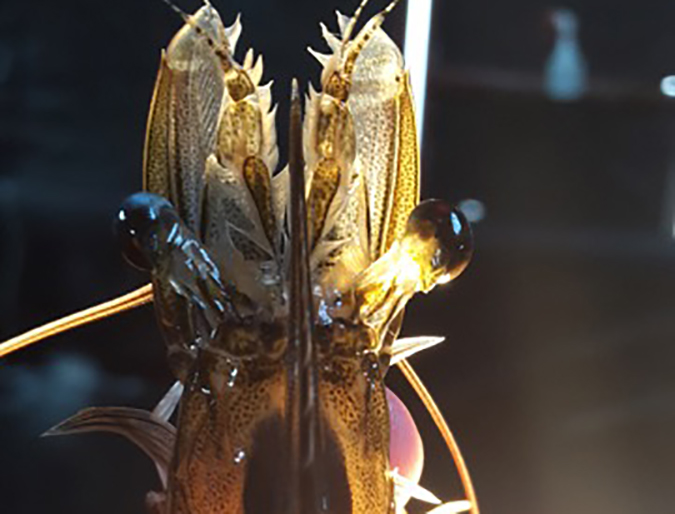
Health & Welfare
Seajoy’s ablation-free shrimp answers emerging welfare concern
Removing the eyestalk of broodstock female shrimp aided in the explosive growth of commercial-scale aquaculture. An undertaking by a Central American shrimp farmer has shown that producing shrimp without ablation can ease animal welfare worries without the feared drop in production.
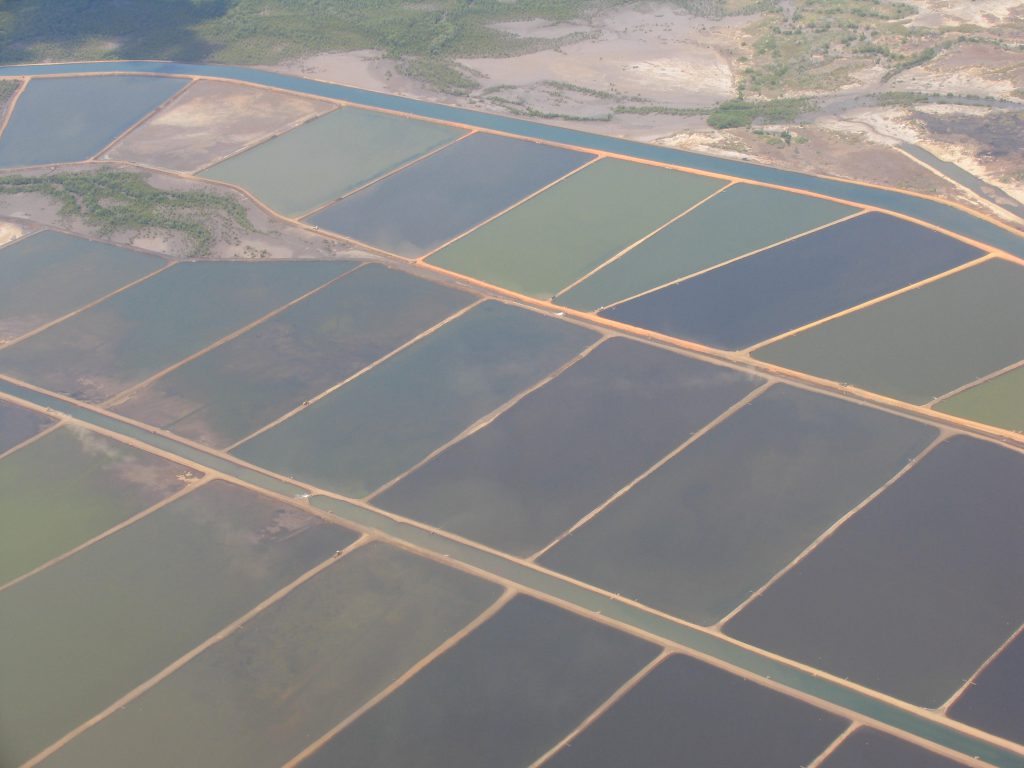
Responsibility
Thoughts on improving responsible aquaculture intervention efforts
Certification programs presently are the best tool to assure that aquaculture products are responsibly produced. But these programs can be burdened by many superfluous requirements and their simplification by focusing primarily on the major issues would be a great improvement.
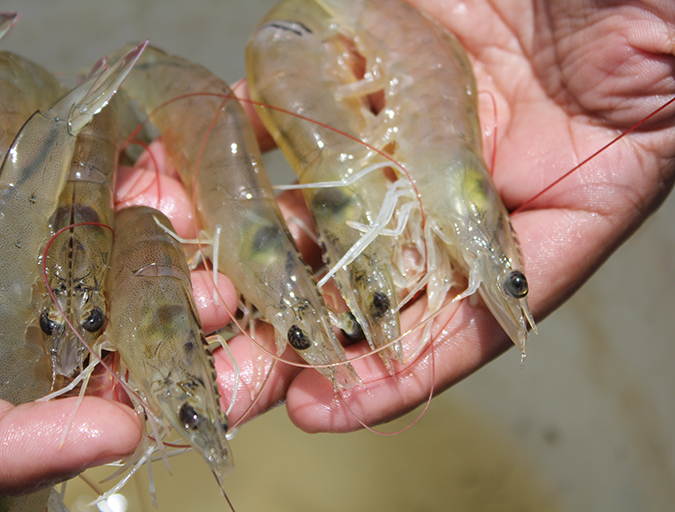
Health & Welfare
Probiotics benefit Pacific white shrimp challenged with AHPND
A study was conducted to measure the effects of commercial probiotics on Pacific white shrimp in a standardized AHPND challenge model under controlled laboratory conditions. Results show that the probiotics treatments by themselves have beneficial effects, such as higher survival and histological signs of hepatopancreas regeneration.

